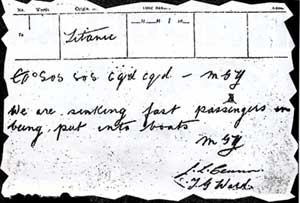April 15, 1912, The Sinking Of The Titanic

On the morning of April 15, 1912, the sinking of the Titanic the
previous night shocked the world. The year had dawned bright with
promise and the maiden voyage of the Titanic was a symbol of the
advances mankind had made in the last few years.
The ship was considered to have been so well constructed it was believed she could sustain any amount of damage and still remain afloat. Late on the night of April 14, 1912, the sinking of the Titanic proved this idea wrong in a horribly tragic way.
The causes of Titanic to sink have been the subject of much
study and debate. Obviously, the instigating factor was the collision
with the iceberg; however the question of 'how did it sink' is frequently the center of most questions regarding the Titanic.
In 1912 the sinking of the Titanic began late on the night of
April 14th. Information on the sinking Titanic indicates that the ship
approached a massive iceberg, and although efforts were made to steer
clear of the large frozen mass, all efforts were to no avail. Sadly,
further records of the Titanic accident history indicate that the
Titanic disaster may very well have been able to have been completely
avoided had officers on ship paid heed to reports received earlier
regarding the frozen waters they were approaching.
Summary of SOS Titanic

SOS Titanic
Even though crew members were desperately trying to turn the ship in
the other direction, when the ship collided with the berg a massive rip
was torn parallel across the ship's bulk. The Titanic sinking began almost immediately, as the ship began to take on water.
Surprisingly, many of the passengers
remained unaware of this fact. Some passengers reported hearing and
feeling a strange quivering in the ship; however, they did not attribute
this to any potential problem and went on about their business.
Others had seen the iceberg has it passed their window and hurriedly
donned dressing gowns and robes, anxious to discover whether or not they
had truly hit the berg. At first, passengers were assured that there
would only be a slight delay and were given no indication of the true
severity of the situation.
Passengers located at strategic points in the ship already knew the
devastating truth however: the Titanic was sinking and sinking fast. An
SOS was sent out to neighboring ships. The Carpathia picked up
the ship's distress call and radioed back to let the ship's crew know
they were on their way. It would be too late, however. By the time the
Carpathia arrived, all that remained of the Titanic was a handful of
lifeboats filled with shocked survivors.
Since the ship sank to her watery grave, almost one hundred years
ago, a number of theories have been put forth to explain how in the year
of 1912 the sinking of the Titanic could have occurred. Some theories
suggest that had the ship's crew not attempted to turn the ship in the
opposite direction of the iceberg and instead took the blow head-on, the
collision would not have resulted in such catastrophic disaster.
Where did the Titanic sink? The Titanic sank
somewhere in the Atlantic Ocean, south of Newfoundland, Canada. Here's a
map with the exact location of the Titanic's resting place. Use the +
and - buttons to zoom, the arrows to move.
Consequently, neighboring ships in the area had
reported earlier in the evening that the waters ahead contained numerous
masses of solid ice and that approaching ships should proceed with
caution. The Titanic, however, thought to be unsinkable, plowed full
speed ahead. This proved to be a fatal mistake and is certainly one of
the factors that led to the disaster.

No comments:
Post a Comment